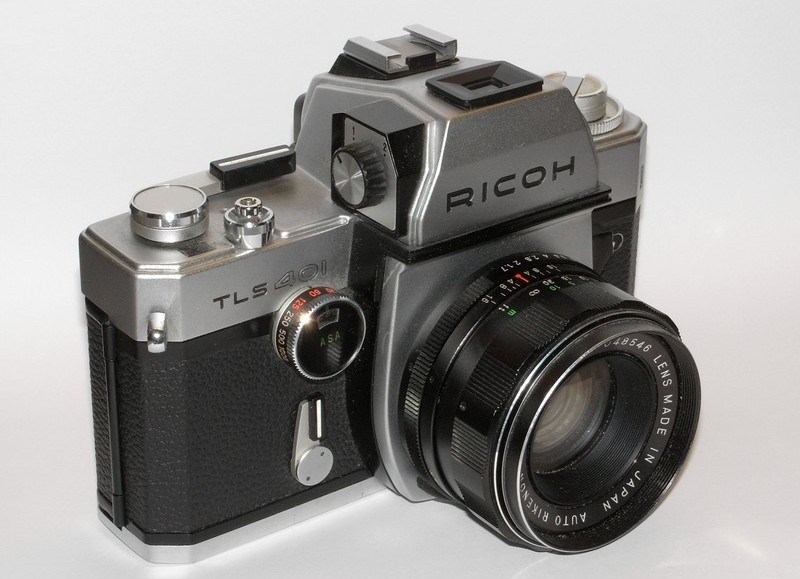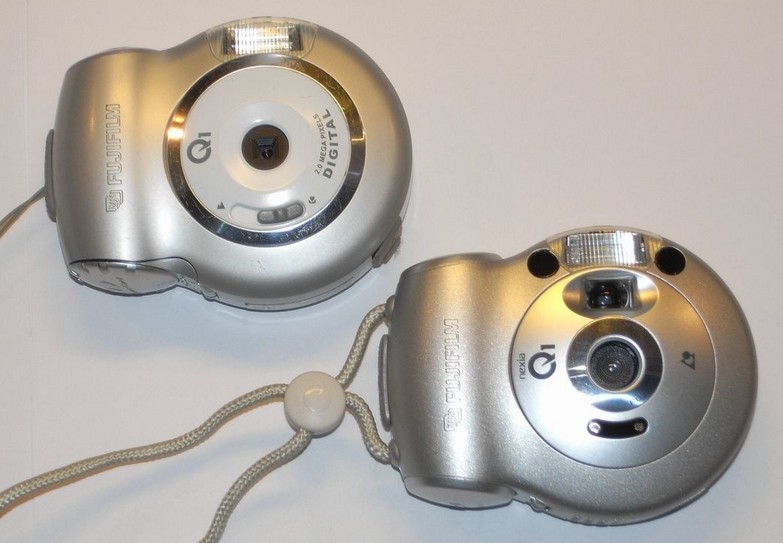The
Express
This is a
„Travel Camera“ and pretty old already. It
doesn’t really belong to this group of cameras, because I
have no knowledge of
comparable cameras and hence I have no idea about its
‘oddity’. The “film
transport” however is worth to be mentioned: The camera works
with sheet film
or glass plates of which quite a number can be pre-loaded in the
camera.
After exposure, when the rear lever is actuated, the last plate clashes
into a
storage chamber and makes room for the next one to be exposed.
Bilora
Bella 66 (1960)
As simple
device, not much advanced over a basic box
camera but certainly much prettier in its pidgeon blue colour. Still,
“continue
to save money until you have enough for a really decent
camera” might have been
good advice…
Sputnik
As far as I
know this was the only classic MF stereo
camera produced after the second world war. Regrettably, the poor
quality shows
in almost every detail, apparently this is an inevitable asset of every
Russian
or GDR production camera. The pictures are nice though…
Ricoh TLS 401 (1971)

I dreamed of
this camera when I was a child, looking
into the camera from above seemed like a fascinating option, somehow
“professional”, like on a Rollei or Hasselblad.
Unfortunately,
this rarely used option means a
miserably dark finder image on all other occasions, while a simple
angle finder
attachment offers the same advantages and leaves the finder image
bright when
not in use. Were the people at Ricoh aware? At least the must have
realized
somewhen, because they did not make another camera of this type (and
nobody
else did either…).
Canon T70 (1984)
Looking back,
the past hype around the Canon T70 camera
seems hard to understand. It must probably be attributed to the
motorized film
transport, which however was so slow that any manual film transport was
equally
fast. Even more so as other comparable cameras (Minolta X-700. Pentax
Super A)
gave the option to be fitted with much faster motors, if needed.
If you take one
in hand now, the buttons seem odd and
not practical, and not being able to see the shutter speed in the
finder is
another disadvantage. But Canon sold them like hot cake…
Agfamatic 6008
Makro Pocket (1977)
Yes, I know,
when the horse is dead, stop beating it,
and since the 110 film format is dead, all these cameras are history.
But the
more expensive Agfamatics have to be listed here together with the
Rollei A110 and the
Pentax auto 110. This 6008
Agfamatic is a sophisticated camera, not even small, for a lot of
money, that
delivered bad pictures, without exception. Looking through old photo
albums you
can see how the pictures changed from small, square and sharp (copies
from MF
negatives) to maybe a little bit bigger, rectangular, equally sharp and
maybe
even in colour (35mm), then square again and much worse (126
“Instamatic”
cassette). And when the pictures turn really
bad, you know that the time of the 110 “pocket”
cassette has come…
Minox EC (1991)
The Minoxes
have to be looked at carefully. Certainly,
the film format (8x11mm) is so small, that it makes for some
advantages, namely
smaller and lighter cameras. The EC, as pictured here, is one of the
lightest
and smallest cameras of all times, in absolute terms. But just how big is this advantage? How many
situations are there, where a 8x11 Minox is appropriate, but, to stay
with
Minox, a Minox 35 is not? Not many, if any.
This Minox EC I
have purchased new in 1991, for a lot
of money. Some years later the price had dropped a lot, as happens
often with
essentially bad products.
I really put
effort in it, I used the most expensive,
finest grain ISO 25 film, and I tried hard to talk me into liking the
pictures
– but today, a look into the photo album reveals without
mercy just how bad the
pictures really are.
Kodak DISC 4000
Camera (1982)
Another
miniature film format, the Disc, has now
disappeared for good. And I hesitate to continue bitching; the
respective
cameras weren’t expensive, after all. Those were flat, pretty
small things for
the handbag, that allowed easy film change. Unfortunately, the quality
was too
bad for the customers to accept it in the long run.
Certainly,
Kodak didn’t die of the Disc format. On the
contrary, at the time nobody would have imagined that anything
ever could become a threat to the giant from Rochester.
But if I look at Kodak’s last attempts to gain some foothold
in the consumer
digital camera market of the last years, those somehow remind me of the
Disc
cameras…
Yashica Samurai
X 3.0, Samurai 4000 ix and
Samurai 2100 DG
Two more
examples for the time when the digital age began
– the Yashica Samurai cameras: To the left, the half frame
SLR X 3.0, to the
right the APS compact camera version, and the digital camera in the
middle
(with a finder, but certainly also with a display o look at). Yashica
had
cultivated this form factor for years and years, without breaking sales
records, but at least without going bust. The X 3.0 isn’t bad
at all, it just
hasn’t much of a size advantage over other cameras for the
full 35mm format,
even after the integration of a zoom lens, flash and winder, so that
buying a
real 35mm camera wasn’t a bad alternative.
The APS version
on the other hand is cute (APS is a
very decent format anyway, big enough for all
“hobby” applications and without
the disadvantages of 35mm).
It is difficult
to judge the digital variant, it works
well, but the digital age was still at its very beginning (in 1999) and
the
camera certainly is no match for later cameras.
Fujifilm
Nexia Q1 and Q1 Digital

The other
example is from Fuji,
and it is really a Happy End, in that Fuji has managed to convert
itself from
film to digital very well, contrary to so many other brands (and even
is the
only good film supplier today…) Here we have a funny design,
and a successful
one, in the case of the APS Nexia Q1, that Fuji capitalized on with the
Q1
Digital, equally funny, just digital.
Odd Rollei Cameras
Odd Pentax Cameras
